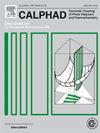Thermodynamic properties of neodymium silicates at high temperature (298.15–1273K) and thermodynamic reassessment of the Nd2O3-SiO2 system
IF 1.9
3区 材料科学
Q4 CHEMISTRY, PHYSICAL
Calphad-computer Coupling of Phase Diagrams and Thermochemistry
Pub Date : 2024-10-22
DOI:10.1016/j.calphad.2024.102760
引用次数: 0
Abstract
Solid oxide fuel cells (SOFCs) have garnered significant interest due to their potential as alternative electrical power generation systems that offer low pollutant emissions and high energy conversion efficiency. Neodymium silicates have emerged as promising electrolyte materials owing to their high ionic conductivity. To enhance our understanding of their performance in SOFC applications, it is essential to investigate the thermodynamic properties of neodymium silicates. In this study, we measured the heat capacities of the prepared samples over the temperature range of 673–1273 K using a multi-high temperature calorimeter (MHTC) 96 line. The temperature dependence of heat capacities for Nd2SiO5, Nd14Si9O39, and Nd2Si2O7 were modeled as functions: Cp(Nd2SiO5) = 194.7 + 0.028 T–4,714,800 T−2 – 239.75 T−0.5 + 491568400 T−3 (J·mol−1·K−1) (298.15 - 1400K), Cp(Nd14Si9O39) =1527.1 + 0.22 T − 40097000 T−2 – 2150.3 T−0.5 + 4424200000 T−3 (J·mol−1·K−1) (298.15 - 1400K), Cp(Nd2Si2O7) =276 + 0.032 T − 8261400 T−2 – 480 T−0.5 + 983136800 T−3 (J mol−1 K−1) (298.15–1400K), and then used for computing changes in entropy and Gibbs free energy. The Nd2O3-SiO2 system was reassessed based on the phase diagram experimental data and measured heat capacities in this work.
高温(298.15-1273K)下硅酸钕的热力学性质以及对 Nd2O3-SiO2 系统的热力学重新评估
固体氧化物燃料电池(SOFC)具有低污染排放和高能量转换效率的潜力,因此作为替代发电系统备受关注。钕硅酸盐具有高离子传导性,因此已成为很有前途的电解质材料。为了进一步了解它们在 SOFC 应用中的性能,研究钕硅酸盐的热力学特性至关重要。在本研究中,我们使用多高温量热仪(MHTC)96 线测量了所制备样品在 673-1273 K 温度范围内的热容量。Nd2SiO5、Nd14Si9O39 和 Nd2Si2O7 的热容与温度的关系被模拟为以下函数:Cp(Nd2SiO5) = 194.7 + 0.028 T-4,714,800 T-2 - 239.75 T-0.5 + 491568400 T-3 (J-mol-1-K-1) (298.15 - 1400K),Cp(Nd14Si9O39) = 1527.1 + 0.22 T - 40097000 T-2 - 2150.3 T-0.5 + 4424200000 T-3 (J-mol-1-K-1) (298.15 - 1400K),Cp(Nd2Si2O7) =276 + 0.032 T - 8261400 T-2 - 480 T-0.5 + 983136800 T-3 (J mol-1 K-1) (298.15-1400K),然后用于计算熵和吉布斯自由能的变化。在这项工作中,根据相图实验数据和测得的热容量对 Nd2O3-SiO2 系统进行了重新评估。
本文章由计算机程序翻译,如有差异,请以英文原文为准。
求助全文
约1分钟内获得全文
求助全文
来源期刊
CiteScore
4.00
自引率
16.70%
发文量
94
审稿时长
2.5 months
期刊介绍:
The design of industrial processes requires reliable thermodynamic data. CALPHAD (Computer Coupling of Phase Diagrams and Thermochemistry) aims to promote computational thermodynamics through development of models to represent thermodynamic properties for various phases which permit prediction of properties of multicomponent systems from those of binary and ternary subsystems, critical assessment of data and their incorporation into self-consistent databases, development of software to optimize and derive thermodynamic parameters and the development and use of databanks for calculations to improve understanding of various industrial and technological processes. This work is disseminated through the CALPHAD journal and its annual conference.

 求助内容:
求助内容: 应助结果提醒方式:
应助结果提醒方式:


